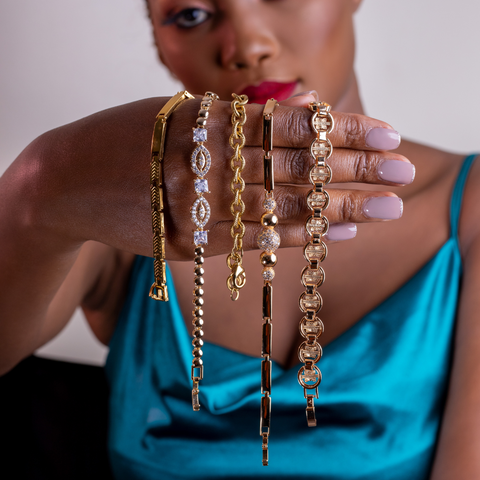Why Jewelry Doesn’t Last As Long As You’d Like
Every woman knows the feeling. You buy a beautiful chain, bracelet, or pair of earrings. For the first few weeks, it sparkles with every outfit. But then, little by little, it starts to fade. The shine dulls, the color changes, and the piece no longer looks as fresh as the day you bought it.
Most women in Kenya think this happens because jewelry is “cheap” or “poor quality.” But the truth is often different. Many times, it’s not the jewelry that’s the problem. It’s the way we care for it. In fact, some of the most common habits Kenyan women practice every day are secretly making jewelry wear out much faster.
Let’s break down six of the biggest jewelry care myths and reveal the simple truths that will keep your favorite pieces shining longer.
1. Myth: Dish soap works for cleaning jewelry
Truth: Many women clean their rings while washing dishes, thinking the soap will help them shine. However, dish soap is designed to cut through grease and oil, which makes it too strong for jewelry finishes. Instead of cleaning, it strips off the protective layer and leaves your piece dull and rough.
Solution: Use a mild jewelry cleaner or soak your pieces in lukewarm water with a drop of gentle baby shampoo. Wipe with a soft, lint-free cloth to keep the shine intact.
2. Myth: Tossing jewelry in one pouch is enough
Truth: Life gets busy. After a long day, it’s easy to throw all your bangles, studs, and chains into one pouch or drawer. But when pieces rub together, they tangle, scratch, and chip off their plating. You might think you’re keeping them safe, but in reality, you’re slowly shortening their life.
Solution: Store each piece separately in small pouches or a lined jewelry box. For women who travel often between Nairobi and Mombasa, this tip is especially helpful since moving jewelry around in one bag only increases damage.
3. Myth: Spraying perfume directly on jewelry makes it shine
Truth: This is a very common mistake. A quick spray of perfume seems to give jewelry a glow, but perfumes contain alcohol and oils that corrode plating. Instead of adding beauty, it leaves behind spots and dull patches that can’t be polished away.
Solution: Apply your perfume and lotions first, let them settle into your skin, and then wear your jewelry. This way, your jewelry stays safe and your look stays flawless.
4. Myth: Jewelry can handle a quick workout
Truth: Kenyan women love to stay active, whether it’s morning jogs at Karura Forest or gym sessions after work. But wearing jewelry while working out exposes it to sweat, constant friction, and even accidental pulls from workout equipment. Over time, this weakens delicate links and makes pieces corrode faster.
Solution: Always remove jewelry before any workout. If you love accessorizing at the gym, switch to simple silicone or fabric bands that don’t get damaged by sweat. Save your fine jewelry for after your workout when you can enjoy it without worry.
5. Myth: Swimming with jewelry is harmless
Truth: A quick dip at the pool in Nairobi or a swim at the Coast feels relaxing, but both chlorine and saltwater are enemies of jewelry. Chlorine breaks down finishes, while saltwater dries out metals and stones. What looks fine after a swim ends up faded and patchy within a short time.
Solution: Make it a rule: no jewelry in the pool or ocean. Keep a small pouch in your beach or gym bag where you can safely store your pieces before swimming.
6. Myth: Scrubbing harder makes jewelry shine brighter
Truth: Many women use rough brushes or scrubbing pads to clean jewelry. The harder you scrub, the more you believe you’re polishing. But in reality, you’re scratching off the protective coating that gives jewelry its glow. The result? Pieces that look older, not newer.
Solution: Treat jewelry with a gentle touch. Use soft cloths or microfiber fabric to wipe down pieces. For stubborn spots, soak in mild water instead of scrubbing.
Why These Myths Spread So Easily
Most of these habits come from convenience. Kenyan women juggle busy lives with work, family, and social events. Quick fixes like scrubbing jewelry or tossing it into a pouch seem harmless in the moment. But over weeks and months, these shortcuts quietly eat away at durability.
Another reason is advice passed down from friends, aunties, or even shop attendants who may not know better. The result is the same: women keep repeating these habits without realizing the long-term effects.
The Simple Path to Longer-Lasting Jewelry
Durability doesn’t have to feel like hard work. Here are five simple habits you can start today:
- Clean gently with mild soap alternatives or jewelry wipes.
- Store smartly by keeping pieces separate in pouches or boxes.
- Apply first, wear later when using perfume, lotions, or oils.
- Remove jewelry before workouts, chores, or swimming.
- Wipe after wear to remove sweat, dust, and oils from the day.
These small shifts don’t just protect your jewelry. They also protect your investment, your style, and your confidence.
Final Thoughts
Jewelry is more than decoration. It’s part of your personal story. Whether it’s the necklace you wear to chama meetings, the earrings for weddings, or the bracelet that makes you feel powerful at work, these pieces deserve care that keeps them shining.
By letting go of old myths and embracing simple truths, Kenyan women can enjoy jewelry that not only looks beautiful but also lasts through life’s moments, big and small.
If you’re ready to enjoy jewelry that’s built to last, explore Royal Gems’ collection of high-quality pieces. Crafted for women who invest in elegance, our jewelry combines beauty with durability so you can shine with confidence every day.



